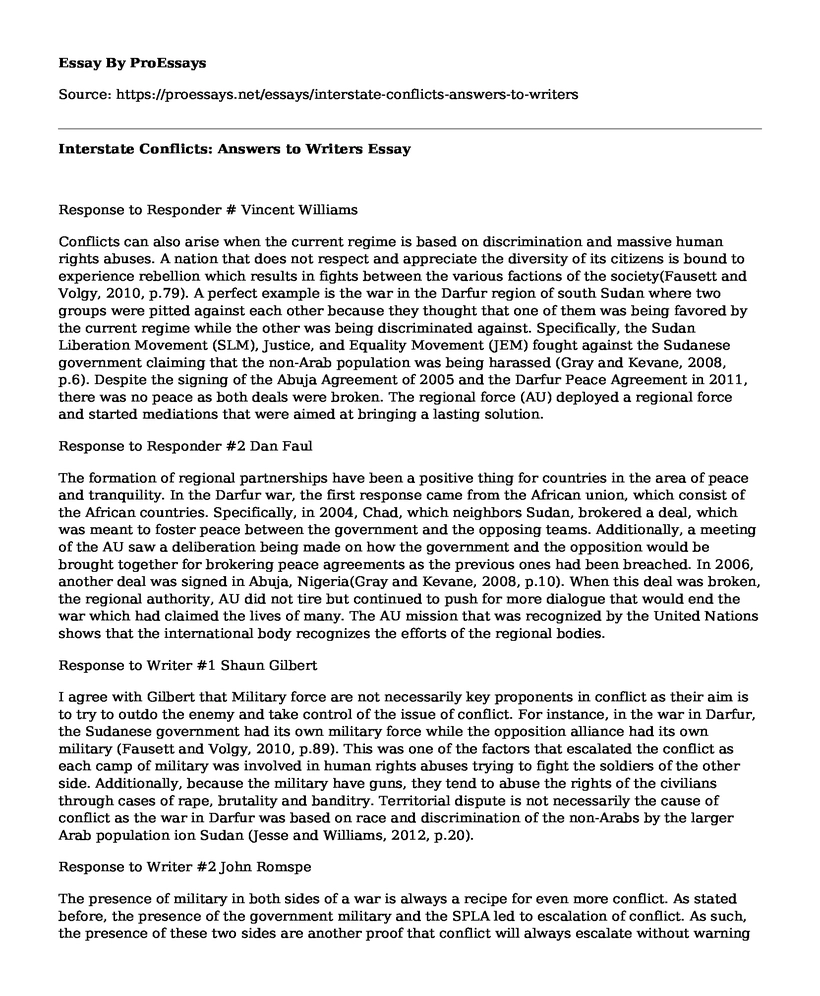Response to Responder # Vincent Williams
Conflicts can also arise when the current regime is based on discrimination and massive human rights abuses. A nation that does not respect and appreciate the diversity of its citizens is bound to experience rebellion which results in fights between the various factions of the society(Fausett and Volgy, 2010, p.79). A perfect example is the war in the Darfur region of south Sudan where two groups were pitted against each other because they thought that one of them was being favored by the current regime while the other was being discriminated against. Specifically, the Sudan Liberation Movement (SLM), Justice, and Equality Movement (JEM) fought against the Sudanese government claiming that the non-Arab population was being harassed (Gray and Kevane, 2008, p.6). Despite the signing of the Abuja Agreement of 2005 and the Darfur Peace Agreement in 2011, there was no peace as both deals were broken. The regional force (AU) deployed a regional force and started mediations that were aimed at bringing a lasting solution.
Response to Responder #2 Dan Faul
The formation of regional partnerships have been a positive thing for countries in the area of peace and tranquility. In the Darfur war, the first response came from the African union, which consist of the African countries. Specifically, in 2004, Chad, which neighbors Sudan, brokered a deal, which was meant to foster peace between the government and the opposing teams. Additionally, a meeting of the AU saw a deliberation being made on how the government and the opposition would be brought together for brokering peace agreements as the previous ones had been breached. In 2006, another deal was signed in Abuja, Nigeria(Gray and Kevane, 2008, p.10). When this deal was broken, the regional authority, AU did not tire but continued to push for more dialogue that would end the war which had claimed the lives of many. The AU mission that was recognized by the United Nations shows that the international body recognizes the efforts of the regional bodies.
Response to Writer #1 Shaun Gilbert
I agree with Gilbert that Military force are not necessarily key proponents in conflict as their aim is to try to outdo the enemy and take control of the issue of conflict. For instance, in the war in Darfur, the Sudanese government had its own military force while the opposition alliance had its own military (Fausett and Volgy, 2010, p.89). This was one of the factors that escalated the conflict as each camp of military was involved in human rights abuses trying to fight the soldiers of the other side. Additionally, because the military have guns, they tend to abuse the rights of the civilians through cases of rape, brutality and banditry. Territorial dispute is not necessarily the cause of conflict as the war in Darfur was based on race and discrimination of the non-Arabs by the larger Arab population ion Sudan (Jesse and Williams, 2012, p.20).
Response to Writer #2 John Romspe
The presence of military in both sides of a war is always a recipe for even more conflict. As stated before, the presence of the government military and the SPLA led to escalation of conflict. As such, the presence of these two sides are another proof that conflict will always escalate without warning and approval. Additionally, the number peace agreements that have been broken shows that diplomacy cannot sometimes solve the issue (Gbowee, 2013, p.23). Additionally, the fact that the AU mission failed shows that the military is not an adequate solution to conflict, as such; there must be a balance between military intervention and diplomacy (Fausett and Volgy, 2010, p.83). The use of one may be ineffective. Additionally, the political volatility between Sudan and south Sudan was also a contributing factor. As such, it is very difficult to attribute war to a single thing.
References
Fausett, E. and Volgy, T.J., 2010. Intergovernmental organizations (IGOs) and interstate conflict: Parsing out IGO effects for alternative dimensions of conflict in postcommunist space. International Studies Quarterly, 54(1), pp.79-101.
Gbowee, L., 2013. Transforming Conflict through Nonviolent Coalitions. Jesse, N.G. and Williams, K.P., 2012. Identity and Institutions: Conflict Reduction in Divided Societies. SUNY Press.Gray, L. and Kevane, M., 2008. Darfur: rainfall and conflict. Available at SSRN 1147303.
Cite this page
Interstate Conflicts: Answers to Writers. (2021, Mar 22). Retrieved from https://proessays.net/essays/interstate-conflicts-answers-to-writers
If you are the original author of this essay and no longer wish to have it published on the ProEssays website, please click below to request its removal:
- Regionalism and Trade Liberalization
- BRICS Development Bank as an Alternative to IMF in Africa: Quantitative and Qualitative Hypotheses Testing
- Economics of International Trade Essay Example
- Research Paper on Global Issues Influence on Domestic Policy
- Essay on UNDP: Global Network for Positive Change and Sustainable Development
- Paper Example on Tariffs: A Response to Trade Deficits and Imperfect Competition
- China's WTO Entry: Pressure to Go Beyond the Norm - Essay Sample







